Agile Business Analysis Report: Requirements, Management, and Goals
VerifiedAdded on 2021/06/17
|14
|3256
|357
Report
AI Summary
This report delves into the realm of Agile Business Analysis, focusing on requirements, stakeholder management, and product vision within the context of the "Griffith 2020 Digital Strategy" project. It explores the application of Agile methodologies to address business needs and deliver quality software efficiently. The report outlines business goals, stakeholder communication strategies, and the use of tools like Kano analysis and product roadmaps for effective product development. Furthermore, it examines Agile requirements, including backlog grooming and story decomposition techniques, along with delivery and review processes using Scrum boards. The report also covers Agile project management frameworks, emphasizing iterative development, flexibility, and team collaboration to achieve project success.
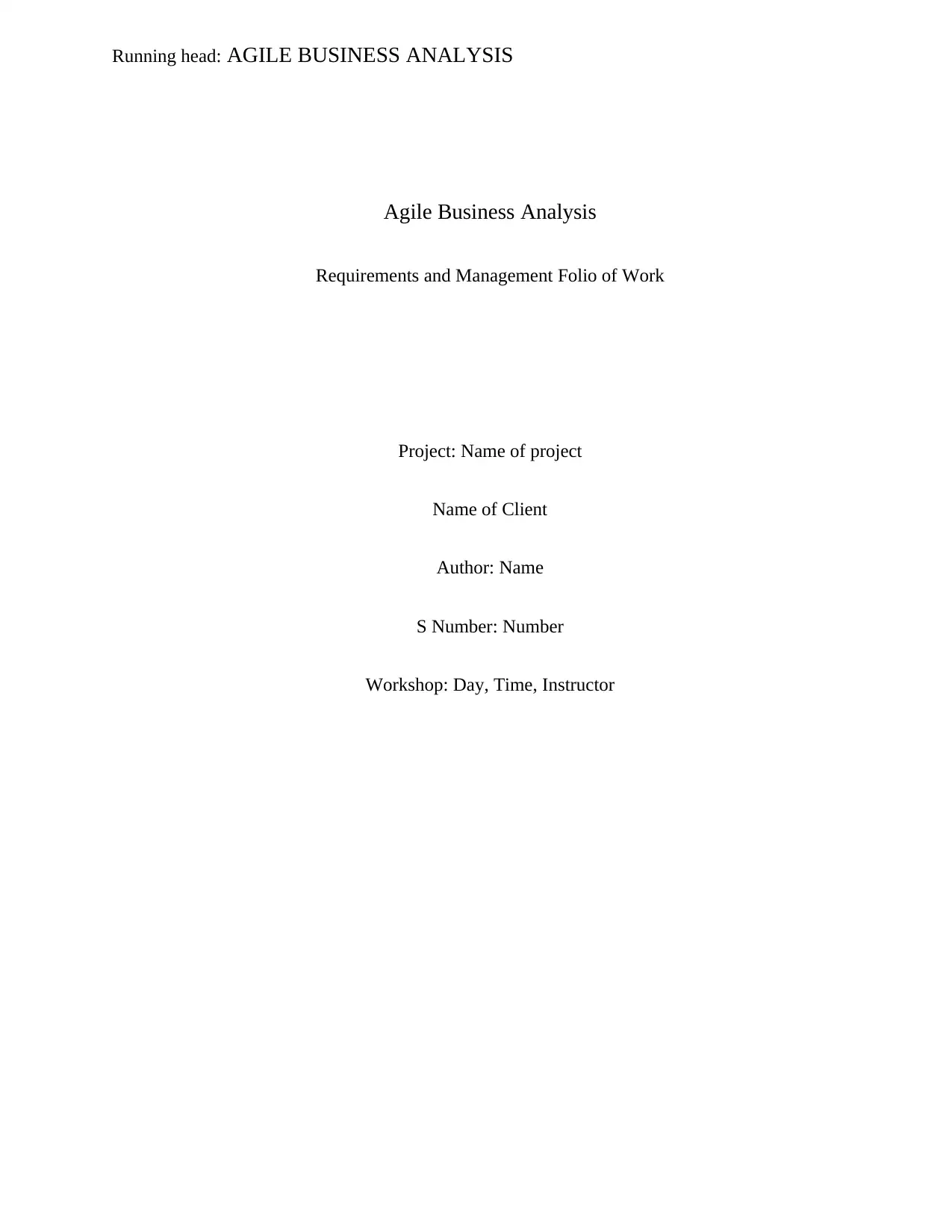
Running head: AGILE BUSINESS ANALYSIS
Agile Business Analysis
Requirements and Management Folio of Work
Project: Name of project
Name of Client
Author: Name
S Number: Number
Workshop: Day, Time, Instructor
Agile Business Analysis
Requirements and Management Folio of Work
Project: Name of project
Name of Client
Author: Name
S Number: Number
Workshop: Day, Time, Instructor
Paraphrase This Document
Need a fresh take? Get an instant paraphrase of this document with our AI Paraphraser
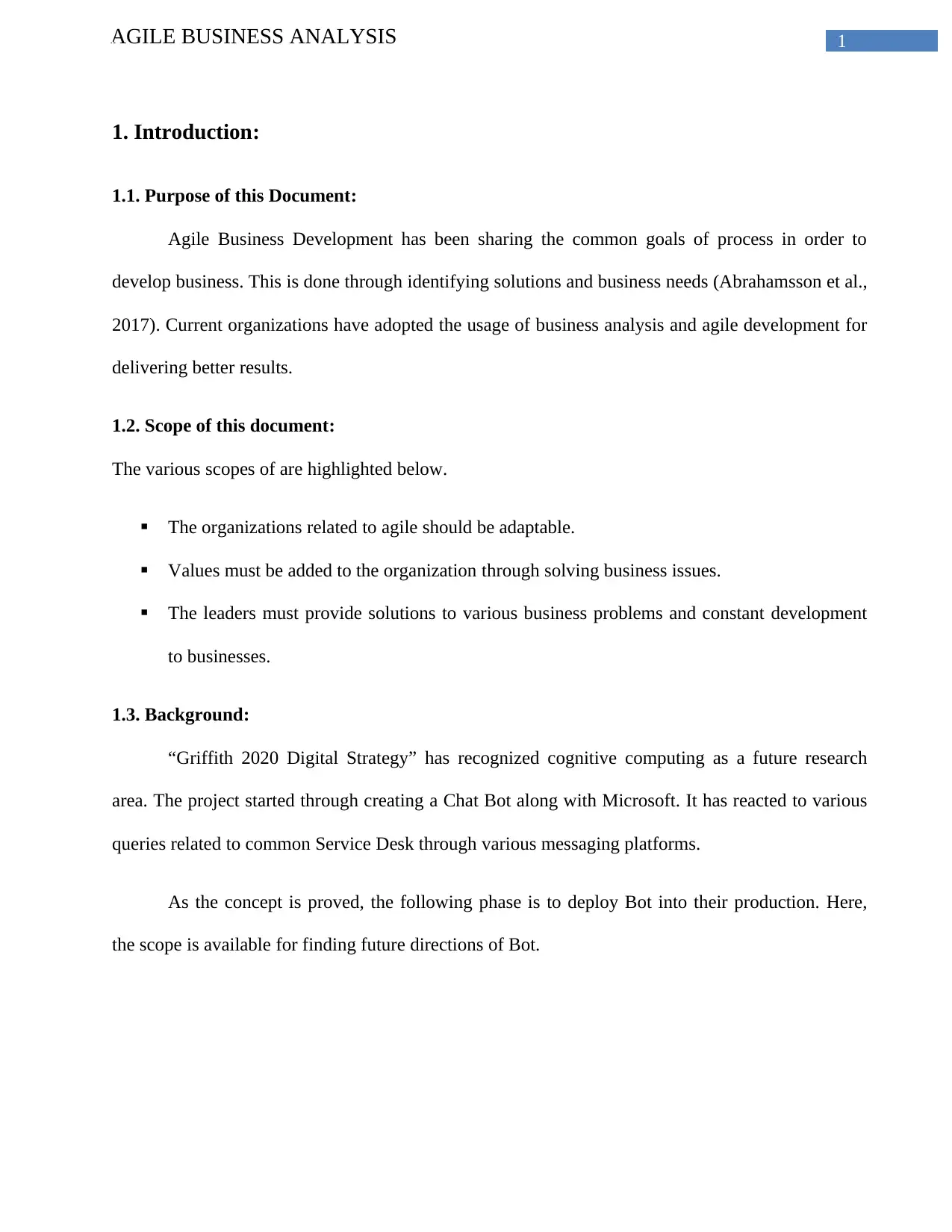
1AGILE BUSINESS ANALYSIS
1. Introduction:
1.1. Purpose of this Document:
Agile Business Development has been sharing the common goals of process in order to
develop business. This is done through identifying solutions and business needs (Abrahamsson et al.,
2017). Current organizations have adopted the usage of business analysis and agile development for
delivering better results.
1.2. Scope of this document:
The various scopes of are highlighted below.
The organizations related to agile should be adaptable.
Values must be added to the organization through solving business issues.
The leaders must provide solutions to various business problems and constant development
to businesses.
1.3. Background:
“Griffith 2020 Digital Strategy” has recognized cognitive computing as a future research
area. The project started through creating a Chat Bot along with Microsoft. It has reacted to various
queries related to common Service Desk through various messaging platforms.
As the concept is proved, the following phase is to deploy Bot into their production. Here,
the scope is available for finding future directions of Bot.
1. Introduction:
1.1. Purpose of this Document:
Agile Business Development has been sharing the common goals of process in order to
develop business. This is done through identifying solutions and business needs (Abrahamsson et al.,
2017). Current organizations have adopted the usage of business analysis and agile development for
delivering better results.
1.2. Scope of this document:
The various scopes of are highlighted below.
The organizations related to agile should be adaptable.
Values must be added to the organization through solving business issues.
The leaders must provide solutions to various business problems and constant development
to businesses.
1.3. Background:
“Griffith 2020 Digital Strategy” has recognized cognitive computing as a future research
area. The project started through creating a Chat Bot along with Microsoft. It has reacted to various
queries related to common Service Desk through various messaging platforms.
As the concept is proved, the following phase is to deploy Bot into their production. Here,
the scope is available for finding future directions of Bot.
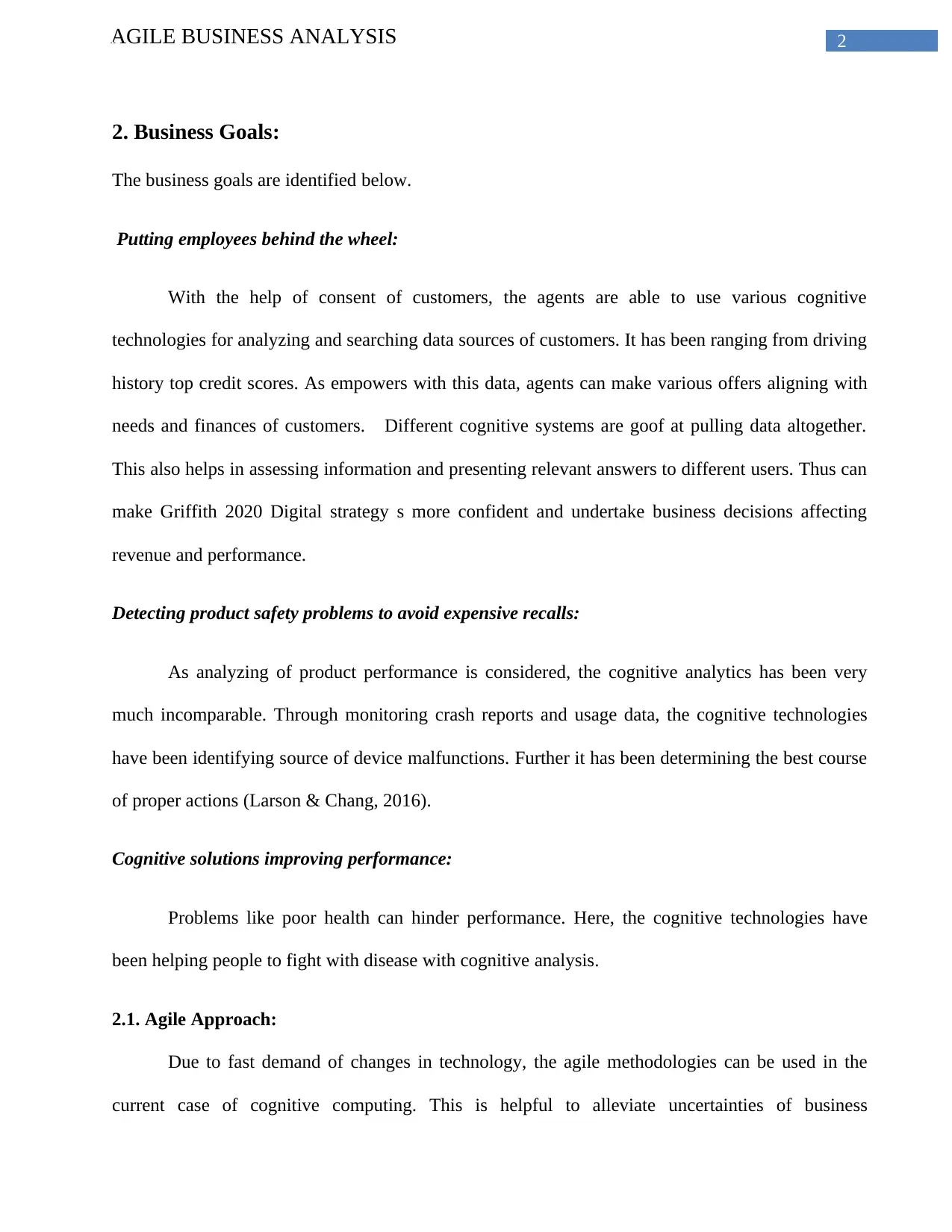
2AGILE BUSINESS ANALYSIS
2. Business Goals:
The business goals are identified below.
Putting employees behind the wheel:
With the help of consent of customers, the agents are able to use various cognitive
technologies for analyzing and searching data sources of customers. It has been ranging from driving
history top credit scores. As empowers with this data, agents can make various offers aligning with
needs and finances of customers. Different cognitive systems are goof at pulling data altogether.
This also helps in assessing information and presenting relevant answers to different users. Thus can
make Griffith 2020 Digital strategy s more confident and undertake business decisions affecting
revenue and performance.
Detecting product safety problems to avoid expensive recalls:
As analyzing of product performance is considered, the cognitive analytics has been very
much incomparable. Through monitoring crash reports and usage data, the cognitive technologies
have been identifying source of device malfunctions. Further it has been determining the best course
of proper actions (Larson & Chang, 2016).
Cognitive solutions improving performance:
Problems like poor health can hinder performance. Here, the cognitive technologies have
been helping people to fight with disease with cognitive analysis.
2.1. Agile Approach:
Due to fast demand of changes in technology, the agile methodologies can be used in the
current case of cognitive computing. This is helpful to alleviate uncertainties of business
2. Business Goals:
The business goals are identified below.
Putting employees behind the wheel:
With the help of consent of customers, the agents are able to use various cognitive
technologies for analyzing and searching data sources of customers. It has been ranging from driving
history top credit scores. As empowers with this data, agents can make various offers aligning with
needs and finances of customers. Different cognitive systems are goof at pulling data altogether.
This also helps in assessing information and presenting relevant answers to different users. Thus can
make Griffith 2020 Digital strategy s more confident and undertake business decisions affecting
revenue and performance.
Detecting product safety problems to avoid expensive recalls:
As analyzing of product performance is considered, the cognitive analytics has been very
much incomparable. Through monitoring crash reports and usage data, the cognitive technologies
have been identifying source of device malfunctions. Further it has been determining the best course
of proper actions (Larson & Chang, 2016).
Cognitive solutions improving performance:
Problems like poor health can hinder performance. Here, the cognitive technologies have
been helping people to fight with disease with cognitive analysis.
2.1. Agile Approach:
Due to fast demand of changes in technology, the agile methodologies can be used in the
current case of cognitive computing. This is helpful to alleviate uncertainties of business
⊘ This is a preview!⊘
Do you want full access?
Subscribe today to unlock all pages.

Trusted by 1+ million students worldwide
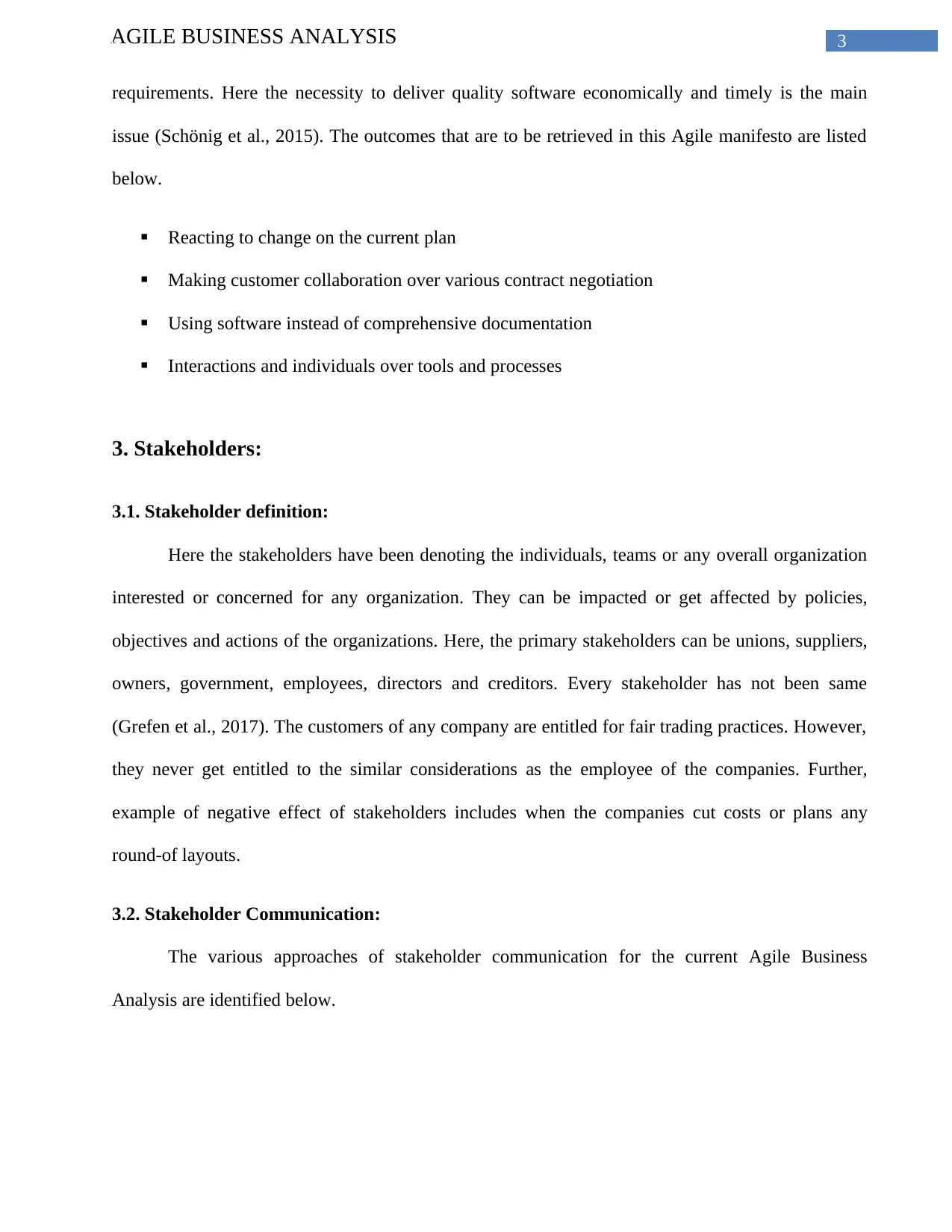
3AGILE BUSINESS ANALYSIS
requirements. Here the necessity to deliver quality software economically and timely is the main
issue (Schönig et al., 2015). The outcomes that are to be retrieved in this Agile manifesto are listed
below.
Reacting to change on the current plan
Making customer collaboration over various contract negotiation
Using software instead of comprehensive documentation
Interactions and individuals over tools and processes
3. Stakeholders:
3.1. Stakeholder definition:
Here the stakeholders have been denoting the individuals, teams or any overall organization
interested or concerned for any organization. They can be impacted or get affected by policies,
objectives and actions of the organizations. Here, the primary stakeholders can be unions, suppliers,
owners, government, employees, directors and creditors. Every stakeholder has not been same
(Grefen et al., 2017). The customers of any company are entitled for fair trading practices. However,
they never get entitled to the similar considerations as the employee of the companies. Further,
example of negative effect of stakeholders includes when the companies cut costs or plans any
round-of layouts.
3.2. Stakeholder Communication:
The various approaches of stakeholder communication for the current Agile Business
Analysis are identified below.
requirements. Here the necessity to deliver quality software economically and timely is the main
issue (Schönig et al., 2015). The outcomes that are to be retrieved in this Agile manifesto are listed
below.
Reacting to change on the current plan
Making customer collaboration over various contract negotiation
Using software instead of comprehensive documentation
Interactions and individuals over tools and processes
3. Stakeholders:
3.1. Stakeholder definition:
Here the stakeholders have been denoting the individuals, teams or any overall organization
interested or concerned for any organization. They can be impacted or get affected by policies,
objectives and actions of the organizations. Here, the primary stakeholders can be unions, suppliers,
owners, government, employees, directors and creditors. Every stakeholder has not been same
(Grefen et al., 2017). The customers of any company are entitled for fair trading practices. However,
they never get entitled to the similar considerations as the employee of the companies. Further,
example of negative effect of stakeholders includes when the companies cut costs or plans any
round-of layouts.
3.2. Stakeholder Communication:
The various approaches of stakeholder communication for the current Agile Business
Analysis are identified below.
Paraphrase This Document
Need a fresh take? Get an instant paraphrase of this document with our AI Paraphraser
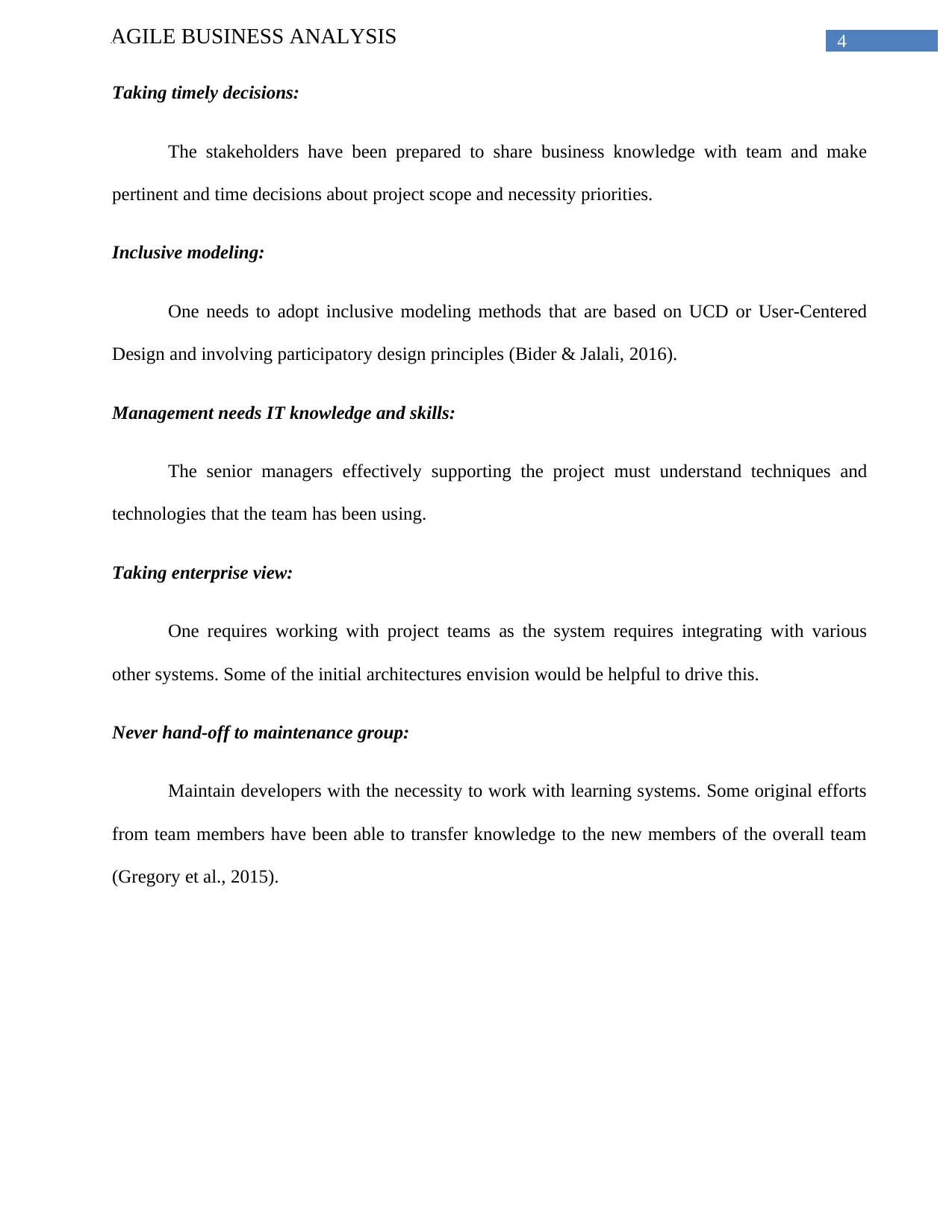
4AGILE BUSINESS ANALYSIS
Taking timely decisions:
The stakeholders have been prepared to share business knowledge with team and make
pertinent and time decisions about project scope and necessity priorities.
Inclusive modeling:
One needs to adopt inclusive modeling methods that are based on UCD or User-Centered
Design and involving participatory design principles (Bider & Jalali, 2016).
Management needs IT knowledge and skills:
The senior managers effectively supporting the project must understand techniques and
technologies that the team has been using.
Taking enterprise view:
One requires working with project teams as the system requires integrating with various
other systems. Some of the initial architectures envision would be helpful to drive this.
Never hand-off to maintenance group:
Maintain developers with the necessity to work with learning systems. Some original efforts
from team members have been able to transfer knowledge to the new members of the overall team
(Gregory et al., 2015).
Taking timely decisions:
The stakeholders have been prepared to share business knowledge with team and make
pertinent and time decisions about project scope and necessity priorities.
Inclusive modeling:
One needs to adopt inclusive modeling methods that are based on UCD or User-Centered
Design and involving participatory design principles (Bider & Jalali, 2016).
Management needs IT knowledge and skills:
The senior managers effectively supporting the project must understand techniques and
technologies that the team has been using.
Taking enterprise view:
One requires working with project teams as the system requires integrating with various
other systems. Some of the initial architectures envision would be helpful to drive this.
Never hand-off to maintenance group:
Maintain developers with the necessity to work with learning systems. Some original efforts
from team members have been able to transfer knowledge to the new members of the overall team
(Gregory et al., 2015).
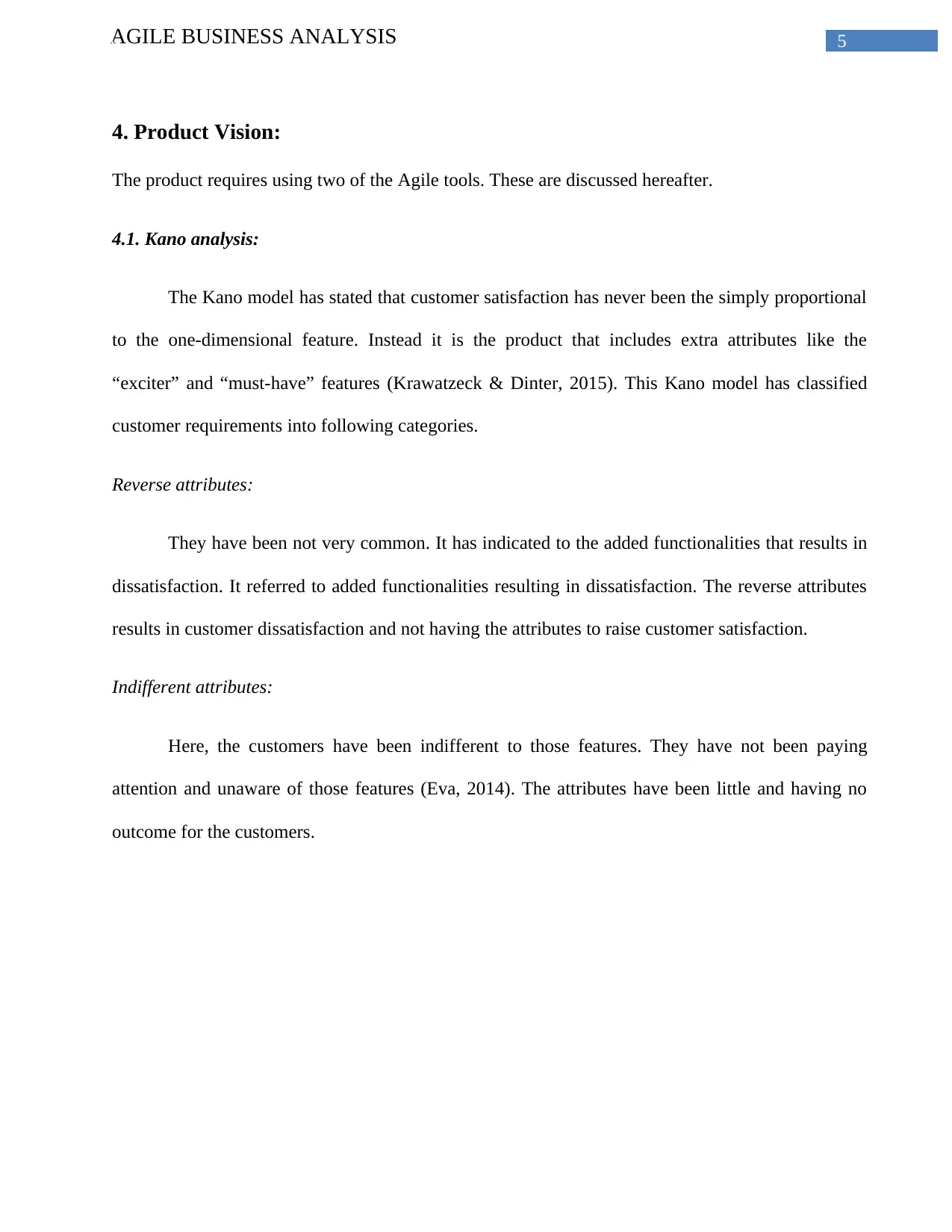
5AGILE BUSINESS ANALYSIS
4. Product Vision:
The product requires using two of the Agile tools. These are discussed hereafter.
4.1. Kano analysis:
The Kano model has stated that customer satisfaction has never been the simply proportional
to the one-dimensional feature. Instead it is the product that includes extra attributes like the
“exciter” and “must-have” features (Krawatzeck & Dinter, 2015). This Kano model has classified
customer requirements into following categories.
Reverse attributes:
They have been not very common. It has indicated to the added functionalities that results in
dissatisfaction. It referred to added functionalities resulting in dissatisfaction. The reverse attributes
results in customer dissatisfaction and not having the attributes to raise customer satisfaction.
Indifferent attributes:
Here, the customers have been indifferent to those features. They have not been paying
attention and unaware of those features (Eva, 2014). The attributes have been little and having no
outcome for the customers.
4. Product Vision:
The product requires using two of the Agile tools. These are discussed hereafter.
4.1. Kano analysis:
The Kano model has stated that customer satisfaction has never been the simply proportional
to the one-dimensional feature. Instead it is the product that includes extra attributes like the
“exciter” and “must-have” features (Krawatzeck & Dinter, 2015). This Kano model has classified
customer requirements into following categories.
Reverse attributes:
They have been not very common. It has indicated to the added functionalities that results in
dissatisfaction. It referred to added functionalities resulting in dissatisfaction. The reverse attributes
results in customer dissatisfaction and not having the attributes to raise customer satisfaction.
Indifferent attributes:
Here, the customers have been indifferent to those features. They have not been paying
attention and unaware of those features (Eva, 2014). The attributes have been little and having no
outcome for the customers.
⊘ This is a preview!⊘
Do you want full access?
Subscribe today to unlock all pages.

Trusted by 1+ million students worldwide
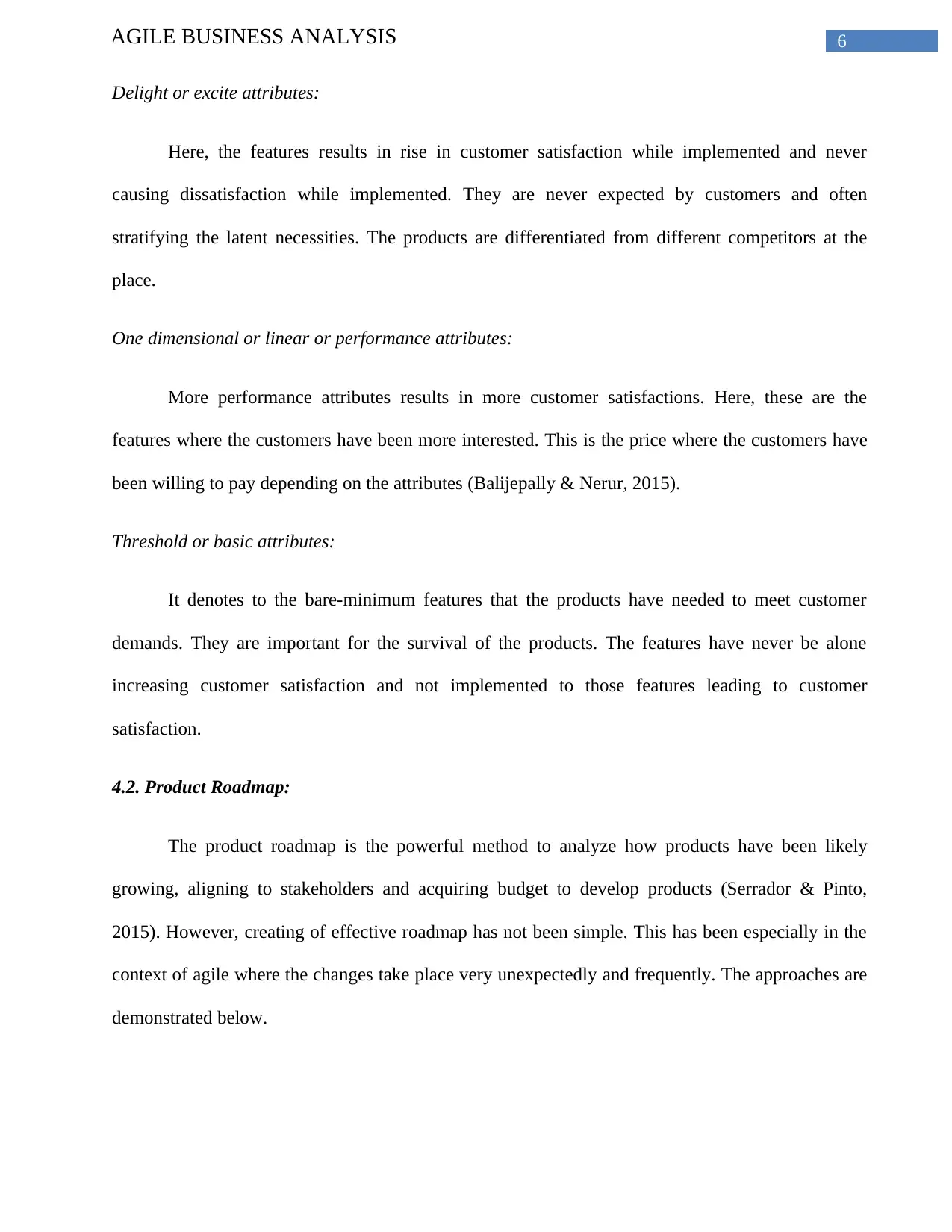
6AGILE BUSINESS ANALYSIS
Delight or excite attributes:
Here, the features results in rise in customer satisfaction while implemented and never
causing dissatisfaction while implemented. They are never expected by customers and often
stratifying the latent necessities. The products are differentiated from different competitors at the
place.
One dimensional or linear or performance attributes:
More performance attributes results in more customer satisfactions. Here, these are the
features where the customers have been more interested. This is the price where the customers have
been willing to pay depending on the attributes (Balijepally & Nerur, 2015).
Threshold or basic attributes:
It denotes to the bare-minimum features that the products have needed to meet customer
demands. They are important for the survival of the products. The features have never be alone
increasing customer satisfaction and not implemented to those features leading to customer
satisfaction.
4.2. Product Roadmap:
The product roadmap is the powerful method to analyze how products have been likely
growing, aligning to stakeholders and acquiring budget to develop products (Serrador & Pinto,
2015). However, creating of effective roadmap has not been simple. This has been especially in the
context of agile where the changes take place very unexpectedly and frequently. The approaches are
demonstrated below.
Delight or excite attributes:
Here, the features results in rise in customer satisfaction while implemented and never
causing dissatisfaction while implemented. They are never expected by customers and often
stratifying the latent necessities. The products are differentiated from different competitors at the
place.
One dimensional or linear or performance attributes:
More performance attributes results in more customer satisfactions. Here, these are the
features where the customers have been more interested. This is the price where the customers have
been willing to pay depending on the attributes (Balijepally & Nerur, 2015).
Threshold or basic attributes:
It denotes to the bare-minimum features that the products have needed to meet customer
demands. They are important for the survival of the products. The features have never be alone
increasing customer satisfaction and not implemented to those features leading to customer
satisfaction.
4.2. Product Roadmap:
The product roadmap is the powerful method to analyze how products have been likely
growing, aligning to stakeholders and acquiring budget to develop products (Serrador & Pinto,
2015). However, creating of effective roadmap has not been simple. This has been especially in the
context of agile where the changes take place very unexpectedly and frequently. The approaches are
demonstrated below.
Paraphrase This Document
Need a fresh take? Get an instant paraphrase of this document with our AI Paraphraser
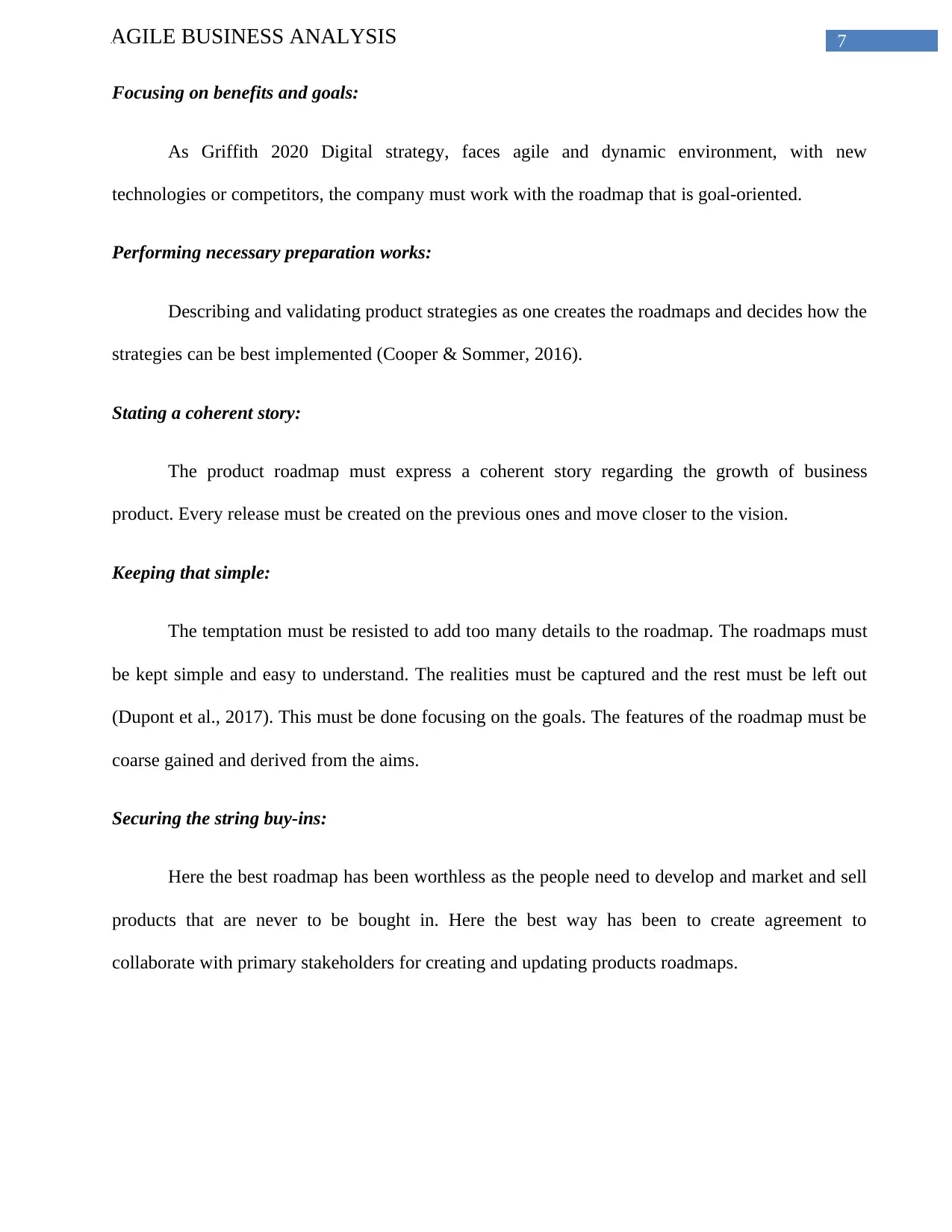
7AGILE BUSINESS ANALYSIS
Focusing on benefits and goals:
As Griffith 2020 Digital strategy, faces agile and dynamic environment, with new
technologies or competitors, the company must work with the roadmap that is goal-oriented.
Performing necessary preparation works:
Describing and validating product strategies as one creates the roadmaps and decides how the
strategies can be best implemented (Cooper & Sommer, 2016).
Stating a coherent story:
The product roadmap must express a coherent story regarding the growth of business
product. Every release must be created on the previous ones and move closer to the vision.
Keeping that simple:
The temptation must be resisted to add too many details to the roadmap. The roadmaps must
be kept simple and easy to understand. The realities must be captured and the rest must be left out
(Dupont et al., 2017). This must be done focusing on the goals. The features of the roadmap must be
coarse gained and derived from the aims.
Securing the string buy-ins:
Here the best roadmap has been worthless as the people need to develop and market and sell
products that are never to be bought in. Here the best way has been to create agreement to
collaborate with primary stakeholders for creating and updating products roadmaps.
Focusing on benefits and goals:
As Griffith 2020 Digital strategy, faces agile and dynamic environment, with new
technologies or competitors, the company must work with the roadmap that is goal-oriented.
Performing necessary preparation works:
Describing and validating product strategies as one creates the roadmaps and decides how the
strategies can be best implemented (Cooper & Sommer, 2016).
Stating a coherent story:
The product roadmap must express a coherent story regarding the growth of business
product. Every release must be created on the previous ones and move closer to the vision.
Keeping that simple:
The temptation must be resisted to add too many details to the roadmap. The roadmaps must
be kept simple and easy to understand. The realities must be captured and the rest must be left out
(Dupont et al., 2017). This must be done focusing on the goals. The features of the roadmap must be
coarse gained and derived from the aims.
Securing the string buy-ins:
Here the best roadmap has been worthless as the people need to develop and market and sell
products that are never to be bought in. Here the best way has been to create agreement to
collaborate with primary stakeholders for creating and updating products roadmaps.
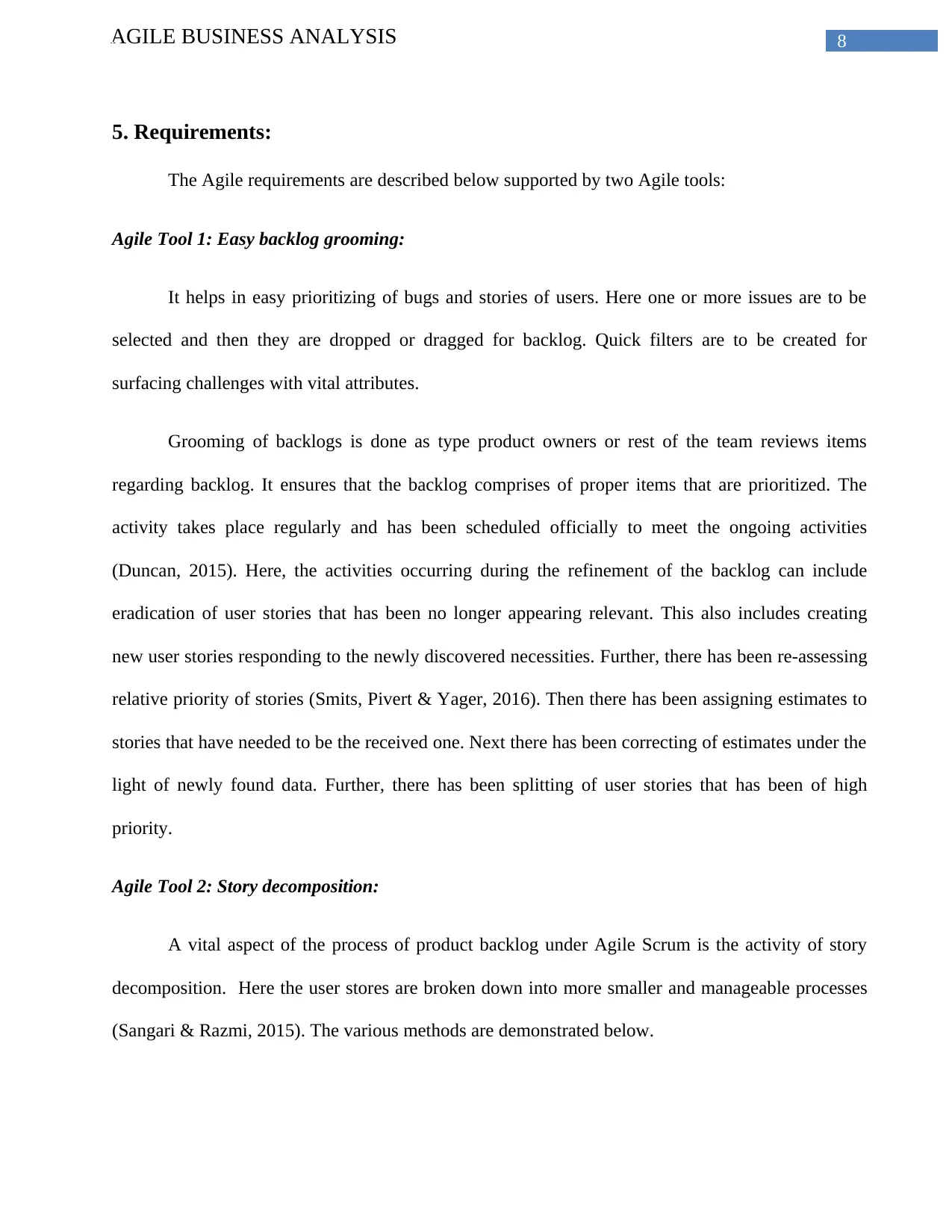
8AGILE BUSINESS ANALYSIS
5. Requirements:
The Agile requirements are described below supported by two Agile tools:
Agile Tool 1: Easy backlog grooming:
It helps in easy prioritizing of bugs and stories of users. Here one or more issues are to be
selected and then they are dropped or dragged for backlog. Quick filters are to be created for
surfacing challenges with vital attributes.
Grooming of backlogs is done as type product owners or rest of the team reviews items
regarding backlog. It ensures that the backlog comprises of proper items that are prioritized. The
activity takes place regularly and has been scheduled officially to meet the ongoing activities
(Duncan, 2015). Here, the activities occurring during the refinement of the backlog can include
eradication of user stories that has been no longer appearing relevant. This also includes creating
new user stories responding to the newly discovered necessities. Further, there has been re-assessing
relative priority of stories (Smits, Pivert & Yager, 2016). Then there has been assigning estimates to
stories that have needed to be the received one. Next there has been correcting of estimates under the
light of newly found data. Further, there has been splitting of user stories that has been of high
priority.
Agile Tool 2: Story decomposition:
A vital aspect of the process of product backlog under Agile Scrum is the activity of story
decomposition. Here the user stores are broken down into more smaller and manageable processes
(Sangari & Razmi, 2015). The various methods are demonstrated below.
5. Requirements:
The Agile requirements are described below supported by two Agile tools:
Agile Tool 1: Easy backlog grooming:
It helps in easy prioritizing of bugs and stories of users. Here one or more issues are to be
selected and then they are dropped or dragged for backlog. Quick filters are to be created for
surfacing challenges with vital attributes.
Grooming of backlogs is done as type product owners or rest of the team reviews items
regarding backlog. It ensures that the backlog comprises of proper items that are prioritized. The
activity takes place regularly and has been scheduled officially to meet the ongoing activities
(Duncan, 2015). Here, the activities occurring during the refinement of the backlog can include
eradication of user stories that has been no longer appearing relevant. This also includes creating
new user stories responding to the newly discovered necessities. Further, there has been re-assessing
relative priority of stories (Smits, Pivert & Yager, 2016). Then there has been assigning estimates to
stories that have needed to be the received one. Next there has been correcting of estimates under the
light of newly found data. Further, there has been splitting of user stories that has been of high
priority.
Agile Tool 2: Story decomposition:
A vital aspect of the process of product backlog under Agile Scrum is the activity of story
decomposition. Here the user stores are broken down into more smaller and manageable processes
(Sangari & Razmi, 2015). The various methods are demonstrated below.
⊘ This is a preview!⊘
Do you want full access?
Subscribe today to unlock all pages.

Trusted by 1+ million students worldwide
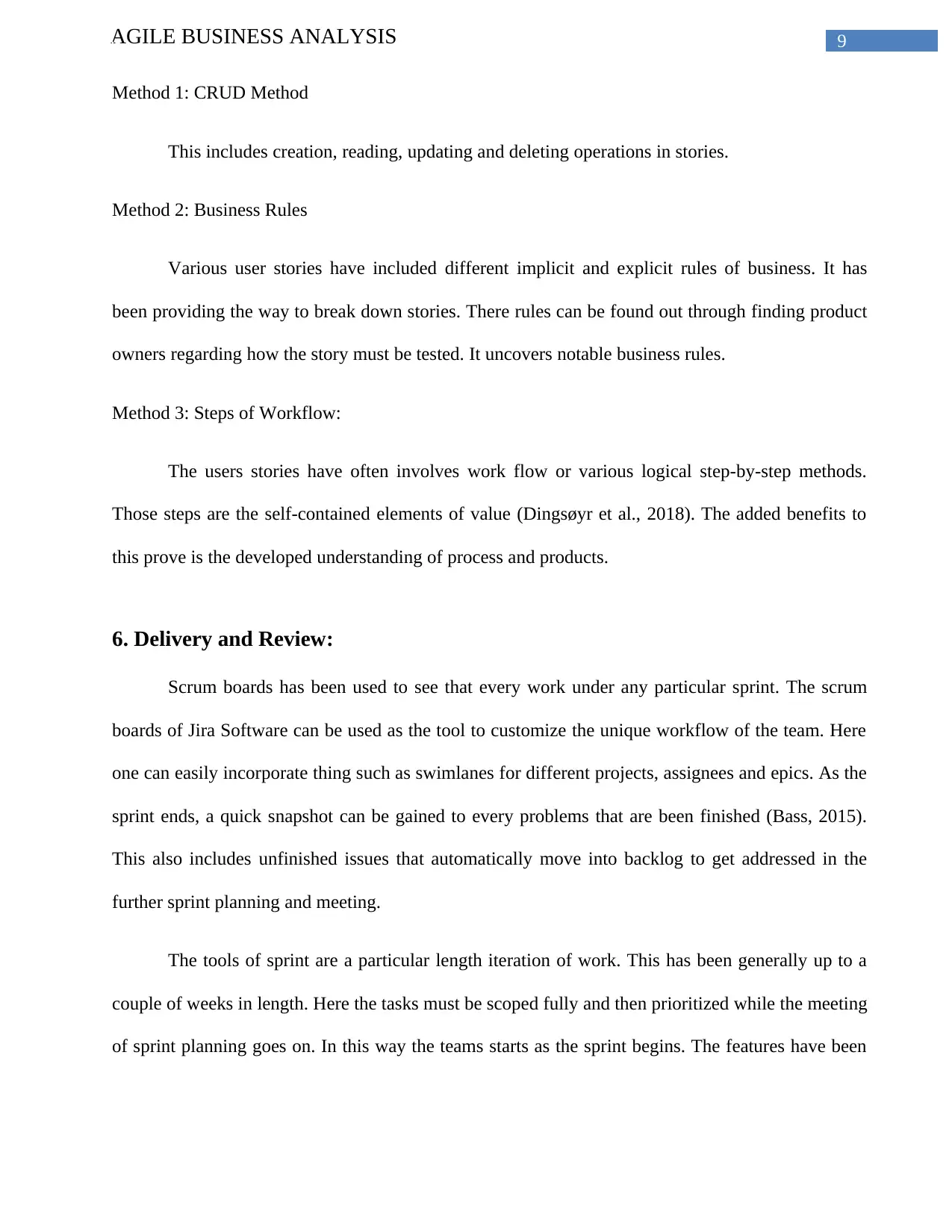
9AGILE BUSINESS ANALYSIS
Method 1: CRUD Method
This includes creation, reading, updating and deleting operations in stories.
Method 2: Business Rules
Various user stories have included different implicit and explicit rules of business. It has
been providing the way to break down stories. There rules can be found out through finding product
owners regarding how the story must be tested. It uncovers notable business rules.
Method 3: Steps of Workflow:
The users stories have often involves work flow or various logical step-by-step methods.
Those steps are the self-contained elements of value (Dingsøyr et al., 2018). The added benefits to
this prove is the developed understanding of process and products.
6. Delivery and Review:
Scrum boards has been used to see that every work under any particular sprint. The scrum
boards of Jira Software can be used as the tool to customize the unique workflow of the team. Here
one can easily incorporate thing such as swimlanes for different projects, assignees and epics. As the
sprint ends, a quick snapshot can be gained to every problems that are been finished (Bass, 2015).
This also includes unfinished issues that automatically move into backlog to get addressed in the
further sprint planning and meeting.
The tools of sprint are a particular length iteration of work. This has been generally up to a
couple of weeks in length. Here the tasks must be scoped fully and then prioritized while the meeting
of sprint planning goes on. In this way the teams starts as the sprint begins. The features have been
Method 1: CRUD Method
This includes creation, reading, updating and deleting operations in stories.
Method 2: Business Rules
Various user stories have included different implicit and explicit rules of business. It has
been providing the way to break down stories. There rules can be found out through finding product
owners regarding how the story must be tested. It uncovers notable business rules.
Method 3: Steps of Workflow:
The users stories have often involves work flow or various logical step-by-step methods.
Those steps are the self-contained elements of value (Dingsøyr et al., 2018). The added benefits to
this prove is the developed understanding of process and products.
6. Delivery and Review:
Scrum boards has been used to see that every work under any particular sprint. The scrum
boards of Jira Software can be used as the tool to customize the unique workflow of the team. Here
one can easily incorporate thing such as swimlanes for different projects, assignees and epics. As the
sprint ends, a quick snapshot can be gained to every problems that are been finished (Bass, 2015).
This also includes unfinished issues that automatically move into backlog to get addressed in the
further sprint planning and meeting.
The tools of sprint are a particular length iteration of work. This has been generally up to a
couple of weeks in length. Here the tasks must be scoped fully and then prioritized while the meeting
of sprint planning goes on. In this way the teams starts as the sprint begins. The features have been
Paraphrase This Document
Need a fresh take? Get an instant paraphrase of this document with our AI Paraphraser
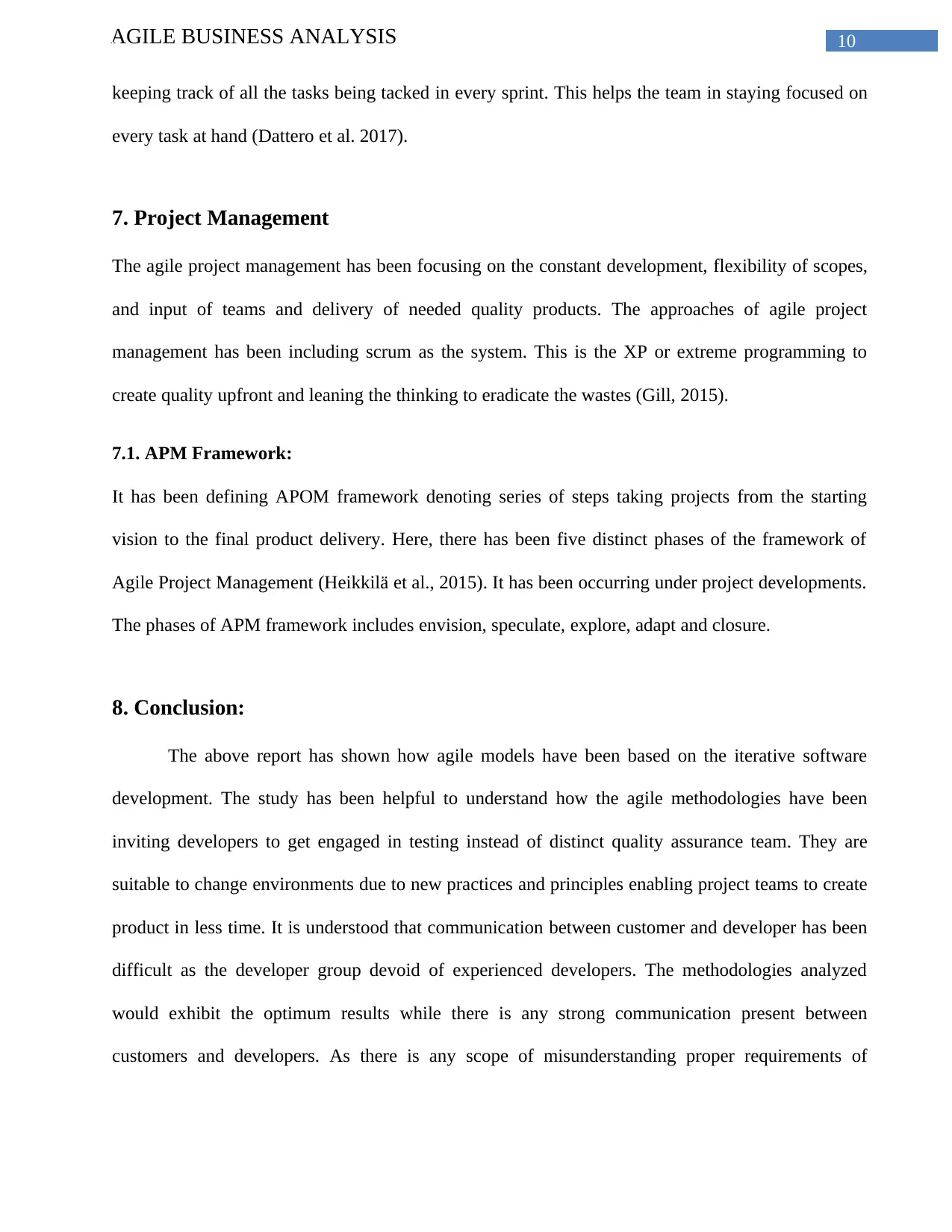
10AGILE BUSINESS ANALYSIS
keeping track of all the tasks being tacked in every sprint. This helps the team in staying focused on
every task at hand (Dattero et al. 2017).
7. Project Management
The agile project management has been focusing on the constant development, flexibility of scopes,
and input of teams and delivery of needed quality products. The approaches of agile project
management has been including scrum as the system. This is the XP or extreme programming to
create quality upfront and leaning the thinking to eradicate the wastes (Gill, 2015).
7.1. APM Framework:
It has been defining APOM framework denoting series of steps taking projects from the starting
vision to the final product delivery. Here, there has been five distinct phases of the framework of
Agile Project Management (Heikkilä et al., 2015). It has been occurring under project developments.
The phases of APM framework includes envision, speculate, explore, adapt and closure.
8. Conclusion:
The above report has shown how agile models have been based on the iterative software
development. The study has been helpful to understand how the agile methodologies have been
inviting developers to get engaged in testing instead of distinct quality assurance team. They are
suitable to change environments due to new practices and principles enabling project teams to create
product in less time. It is understood that communication between customer and developer has been
difficult as the developer group devoid of experienced developers. The methodologies analyzed
would exhibit the optimum results while there is any strong communication present between
customers and developers. As there is any scope of misunderstanding proper requirements of
keeping track of all the tasks being tacked in every sprint. This helps the team in staying focused on
every task at hand (Dattero et al. 2017).
7. Project Management
The agile project management has been focusing on the constant development, flexibility of scopes,
and input of teams and delivery of needed quality products. The approaches of agile project
management has been including scrum as the system. This is the XP or extreme programming to
create quality upfront and leaning the thinking to eradicate the wastes (Gill, 2015).
7.1. APM Framework:
It has been defining APOM framework denoting series of steps taking projects from the starting
vision to the final product delivery. Here, there has been five distinct phases of the framework of
Agile Project Management (Heikkilä et al., 2015). It has been occurring under project developments.
The phases of APM framework includes envision, speculate, explore, adapt and closure.
8. Conclusion:
The above report has shown how agile models have been based on the iterative software
development. The study has been helpful to understand how the agile methodologies have been
inviting developers to get engaged in testing instead of distinct quality assurance team. They are
suitable to change environments due to new practices and principles enabling project teams to create
product in less time. It is understood that communication between customer and developer has been
difficult as the developer group devoid of experienced developers. The methodologies analyzed
would exhibit the optimum results while there is any strong communication present between
customers and developers. As there is any scope of misunderstanding proper requirements of

11AGILE BUSINESS ANALYSIS
customers, the method is the optimum approach for the solution. This takes place as the budgets and
deadlines are tight.
customers, the method is the optimum approach for the solution. This takes place as the budgets and
deadlines are tight.
⊘ This is a preview!⊘
Do you want full access?
Subscribe today to unlock all pages.

Trusted by 1+ million students worldwide
1 out of 14
Related Documents
Your All-in-One AI-Powered Toolkit for Academic Success.
+13062052269
info@desklib.com
Available 24*7 on WhatsApp / Email
![[object Object]](/_next/static/media/star-bottom.7253800d.svg)
Unlock your academic potential
Copyright © 2020–2025 A2Z Services. All Rights Reserved. Developed and managed by ZUCOL.




